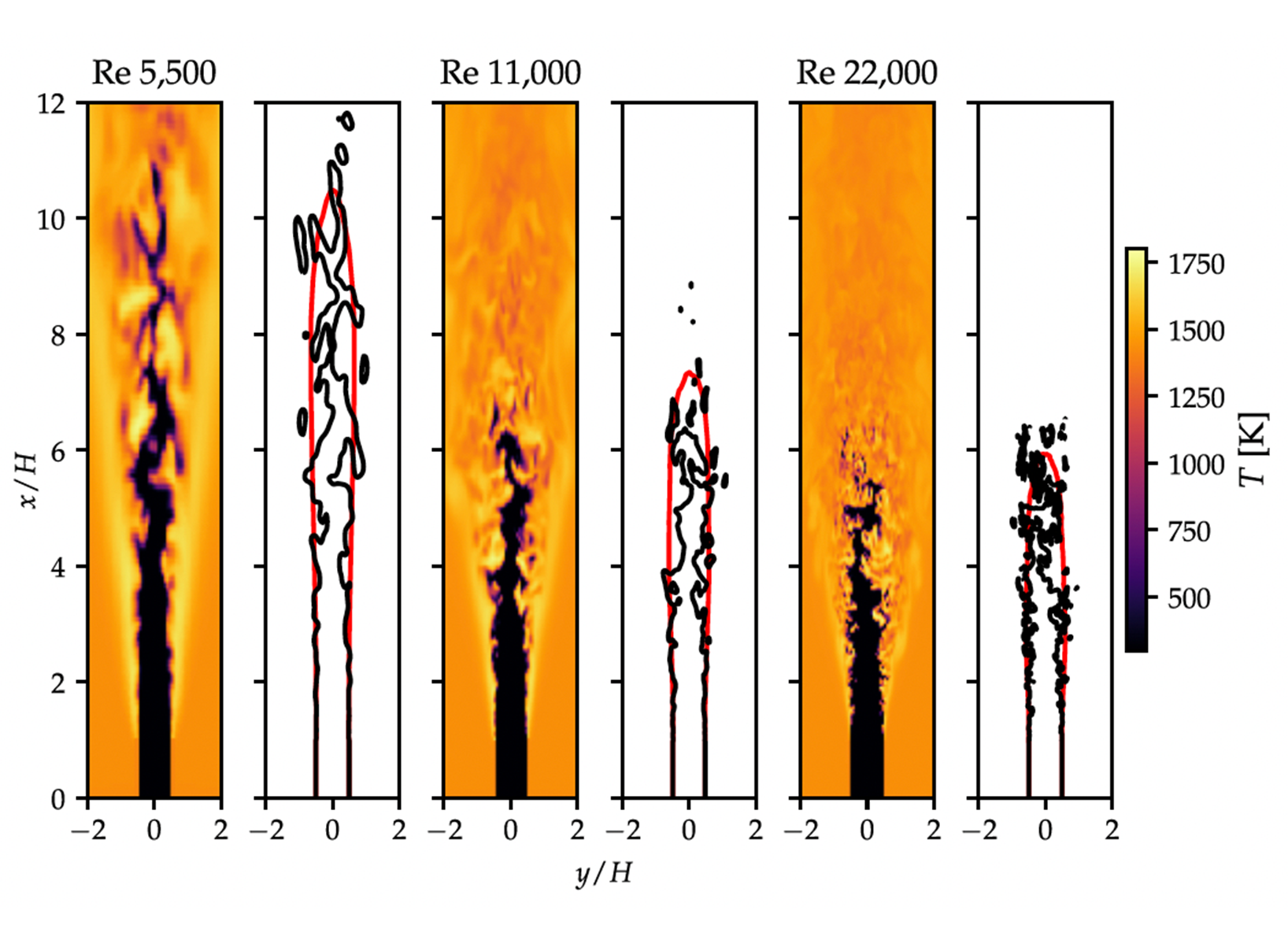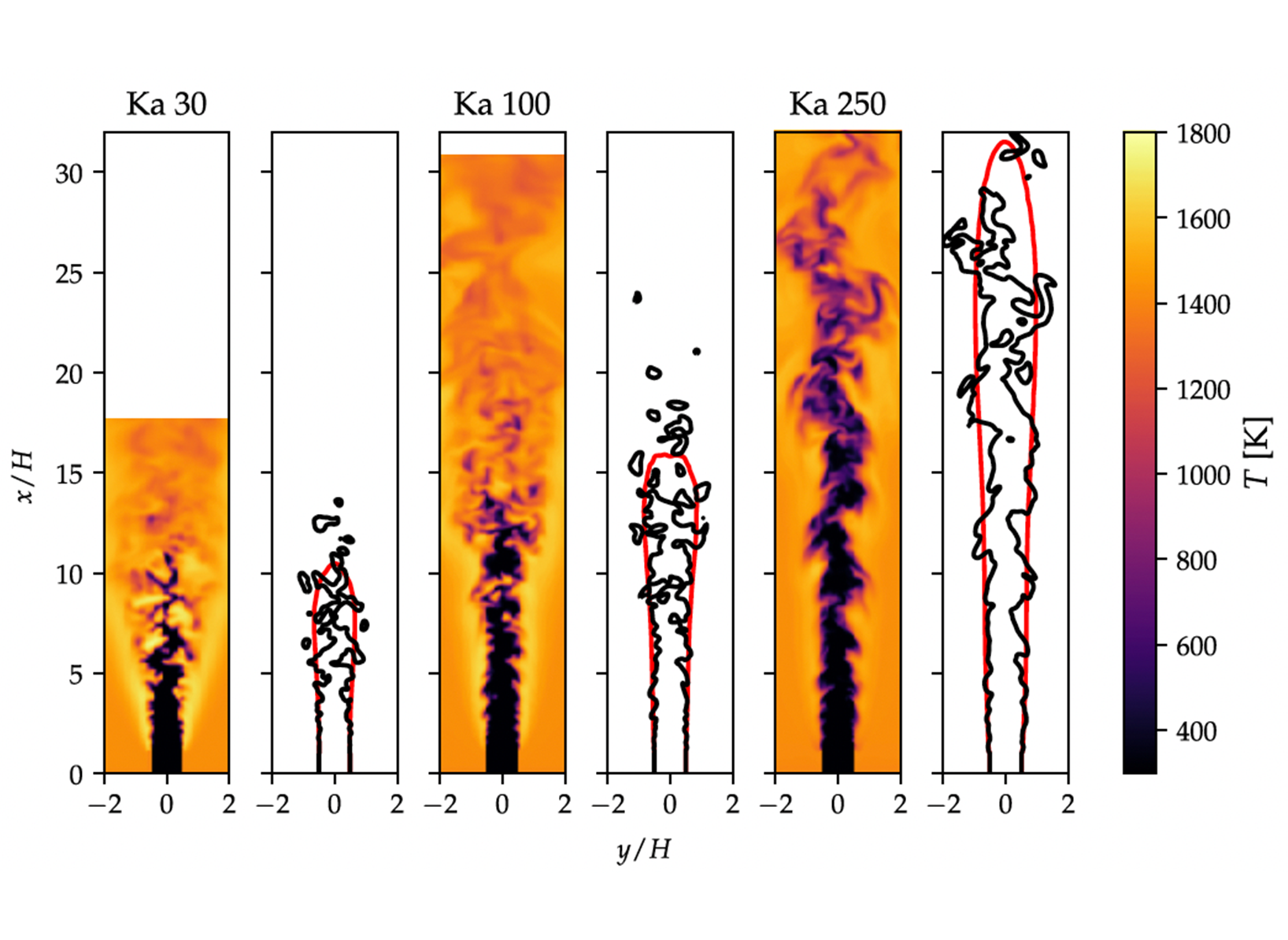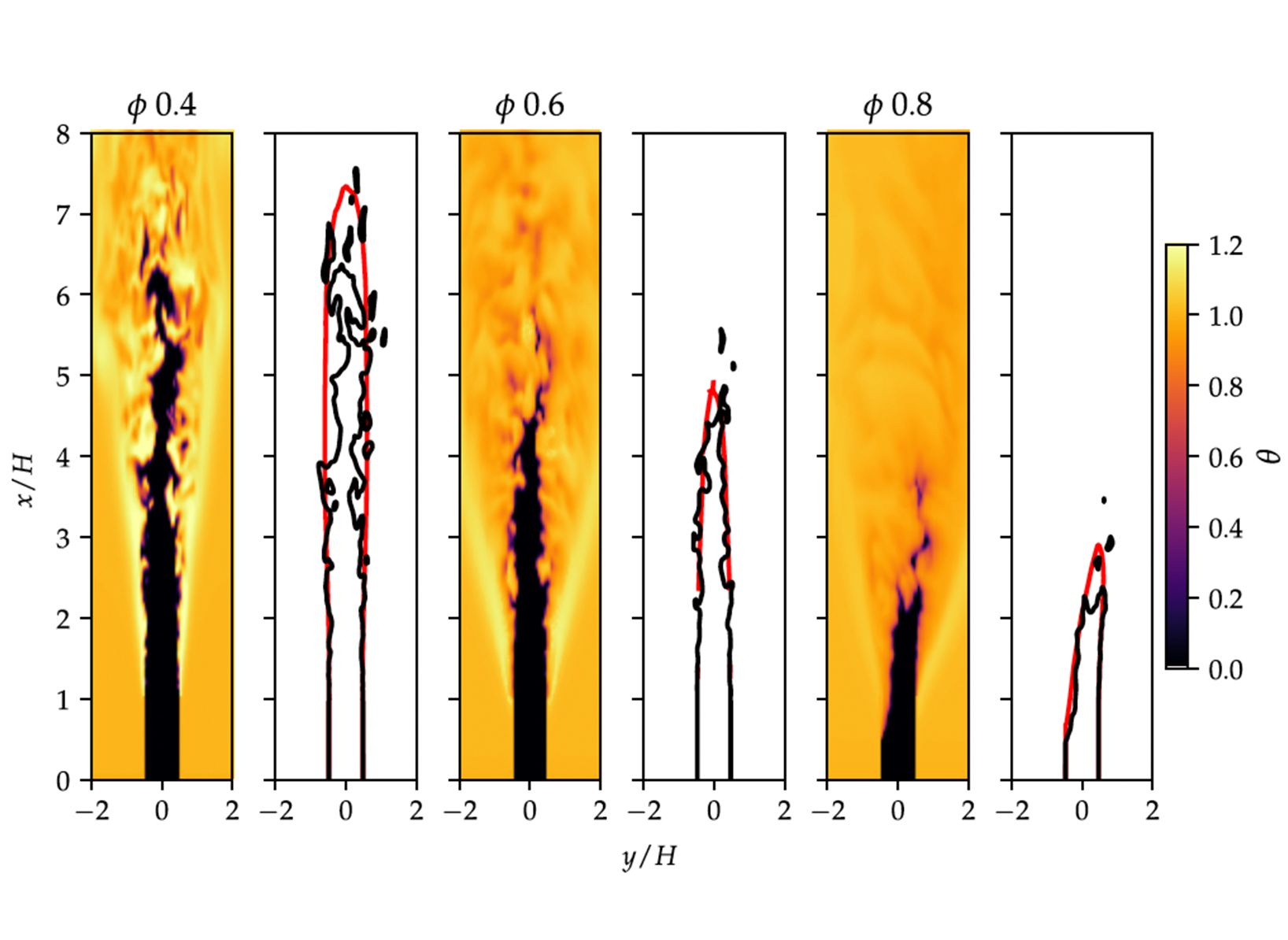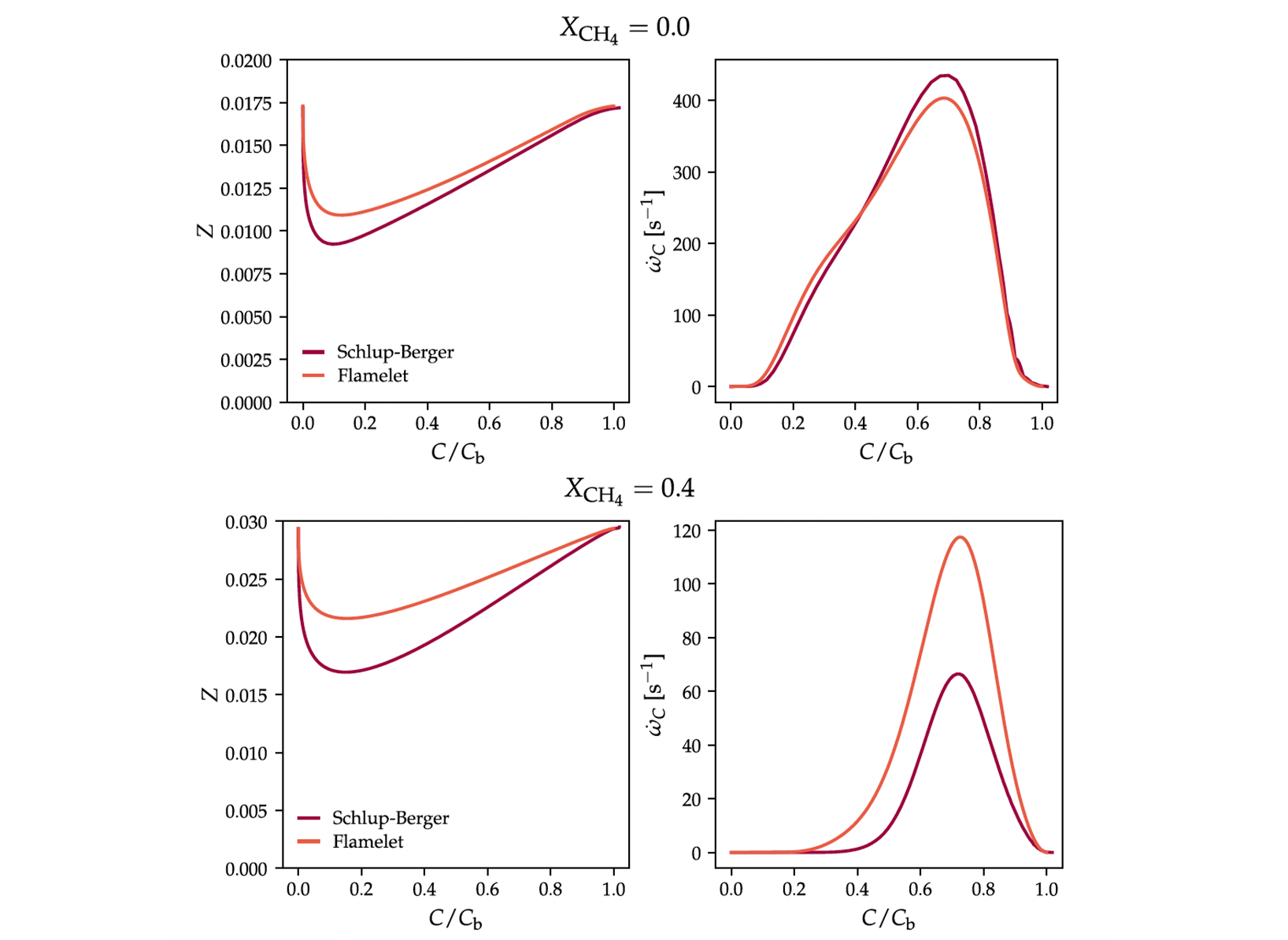Project
Large Eddy Simulations of Lean Premixed Hydrogen-Methane Jet Flames Under Various Operating Conditions
In the gradual transition towards carbon-free energy systems, hydrogen and hydrogenmethane blends play a crucial role in the decarbonization of chemical energy conversion processes. Hydrogen’s great potential in this context comes from its high specific energy, carbon-free nature, and relatively simple synthesis. It is therefore expected to largely replace fossil fuels in related combustion processes over the next decades. To mitigate NOx emissions, flame extinction, and flashback, hydrogen flames are preferably operated under lean conditions. However, lean premixed hydrogen combustion poses specific challenges due to hydrogen’s high molecular diffusivity. In particular, the hydrogen molecule diffuses faster than the heat of combustion, leading to locally varying burning velocities. This causes the flame front to wrinkle, increasing the overall flame surface and thus consumption speed in a phenomenon known as Thermo-Diffusive Instabilities (TDI). High-fidelity simulations can enhance our understanding of TDI to better predict their sensitivity towards changing turbulence and chemistry conditions. Therefore, 10 Large Eddy Simulations (LES) of lean premixed turbulent hydrogen flames were conducted at different Reynolds numbers, Karlovitz numbers, and equivalence ratios. The LES were compared to each other to quantify the effects these quantities have on the overall flame structure. Additionally, the simulations were compared to Direct Numerical Simulations (DNS) computed in another project to validate the flamelet combustion model. Finally, a formulation of the flamelet model was derived in order to accommodate multicomponent fuels, such as methane-hydrogen blends. Validation of 1D simulations with the extended model against simulations with finite-rate chemistry reveals that the model no longer accurately predicts flame behavior, which is why further modifications are necessary.
Project Details
Project term
March 6, 2024–March 5, 2025
Affiliations
RWTH Aachen University
Institute
Institute for Combustion Technology (ITV)
Principal Investigator
Methods
The simulations were performed by means of the in-house reacting flow solver CIAO, which solves the filtered Navier-Stokes equations on a structured staggered Cartesian grid employing distributed memory parallelization using the Message Passing Interface (MPI) standard along Cartesian partitions. For spatial discretization, second-order central differences were employed, except for the scalar convective terms, which were approximated using WENO5 schemes. Time integration was performed using an explicit low-storage five-stage Runge-Kutta (RK) method with second-order accuracy. To account for turbulence-chemistry interactions and TDI, the Regele/Schlup flamelet model was extended, such that it not only parameterizes the filtered progress variable source term over progress variable mean and mixture fraction mean, and , but also the variance of the progress variable . Note that the bar and the tilde denote regular and Favre filtering, respectively. The extension of the Regele/Schlup model was developed in-house in a previous study.
Results
For the Reynolds number variation, three Reynolds numbers, namely 5, 500, 11, 000, and 22, 000, were set by adjusting the slot width at a constant inflow velocity, a Karlovitz number of 30, and an equivalence ratio of 0.4. The corresponding temperature fields are shown in Fig. 1, revealing that the Reynolds number has a profound impact on flame length, in the sense that an increase in the Reynolds number causes a reduction of the normalized flame length. The LES data of the Reynolds number variation generally was consistent with DNS data, which was available for all three Reynolds numbers. The Karlovitz number was varied between the values 30, 100, and 250 by adjusting the slot width in conjunction with the inflow velocity. The Reynolds number was kept at 5, 500 and the equivalence ratio at 0.4. The respective temperature fields are depicted in Fig. 2, revealing that the normalized flame length increases with Karlovitz number. For the equivalence ratio variation, values were set to 0.4, 0.6, and 0.8, while keeping the Reynolds number at 11, 000. As shown in Fig. 3, increasing the equivalence ratio shortens the flame and mitigates effects of TDI, such as flame surface wrinkling and super-adiabatic temperatures. Finally, the flamelet model was extended to accommodate multi-component fuels by deriving a mathematically consistent formulation of the blended fuel properties from the mixture fraction transport equation. For the hydrogen-methane blend, the mixture fraction and source term profiles depicted in Fig. 4 clearly indicate an over-prediction of the mixture fraction and an under-prediction of the progress variable source term by the extended Regele/Schlup model.
Discussion
A novel LES flamelet model was applied in a parameter study to a slot flame case. The three investigated Reynolds numbers revealed an inversely proportional relation between Reynolds number and flame length. This relation is due to synergistic effects of turbulence and chemistry, which increase the consumption speed when the Reynolds number is increased. The three investigated Karlovitz numbers are between the turbulent flame regimes of Thin Reaction Zones (low Ka) and Broken Reaction Zones (high Ka). As turbulent mixing increasingly dominates molecular diffusion at high Karlovitz numbers, TDI and flame wrinkling get less pronounced, which lengthens the flame. It is worth noting that, while the effects of the equivalence ratio on laminar burning velocity and flame temperature are well known from laminar flame theory, this study demonstrates the mitigating effect of increasing equivalence ratios on TDI. Overall, the findings obtained using the Regele/Schlup model offer valuable insights into the behavior of thermodiffusively unstable flames while serving as a computationally efficient tool to obtain extensive datasets with large operating ranges. However, further modifications are required for the Regele/Schlup model to be applied to turbulent hydrogen-methane flames, since preferential and differential diffusion, i.e., the driving factors of TDI, are not captured adequately for blended fuels.
Additional Project Information
DFG classification: 404-03 Fluid Mechanics
Cluster: CLAIX
Publications
Thesis
Niclas Kalter, Large Eddy Simulations of Premixed Hydrogen-Methane Jet Flames Under
Various Operating Conditions, Master Thesis, Aachen, 2024.
 Figure 1: Temperature field of the slot flame at varying Reynolds numbers.
Figure 1: Temperature field of the slot flame at varying Reynolds numbers.  Figure 2: Temperature field of the slot flame at varying Karlovitz numbers.
Figure 2: Temperature field of the slot flame at varying Karlovitz numbers.  Figure 3: Temperature field of the slot flame at varying equivalence ratios.
Figure 3: Temperature field of the slot flame at varying equivalence ratios.  Figure 4: Mixture fraction and progress variable source term profiles over normalized progress variable at varying blend ratios.
Figure 4: Mixture fraction and progress variable source term profiles over normalized progress variable at varying blend ratios.